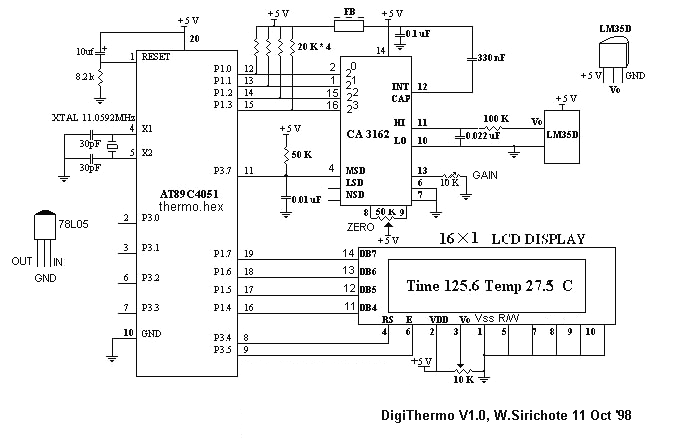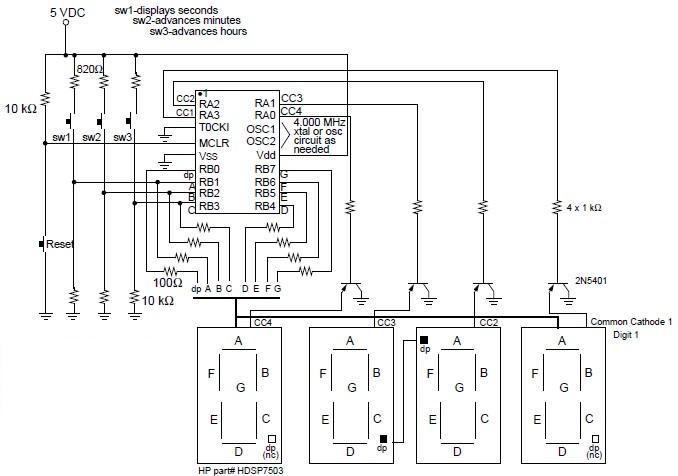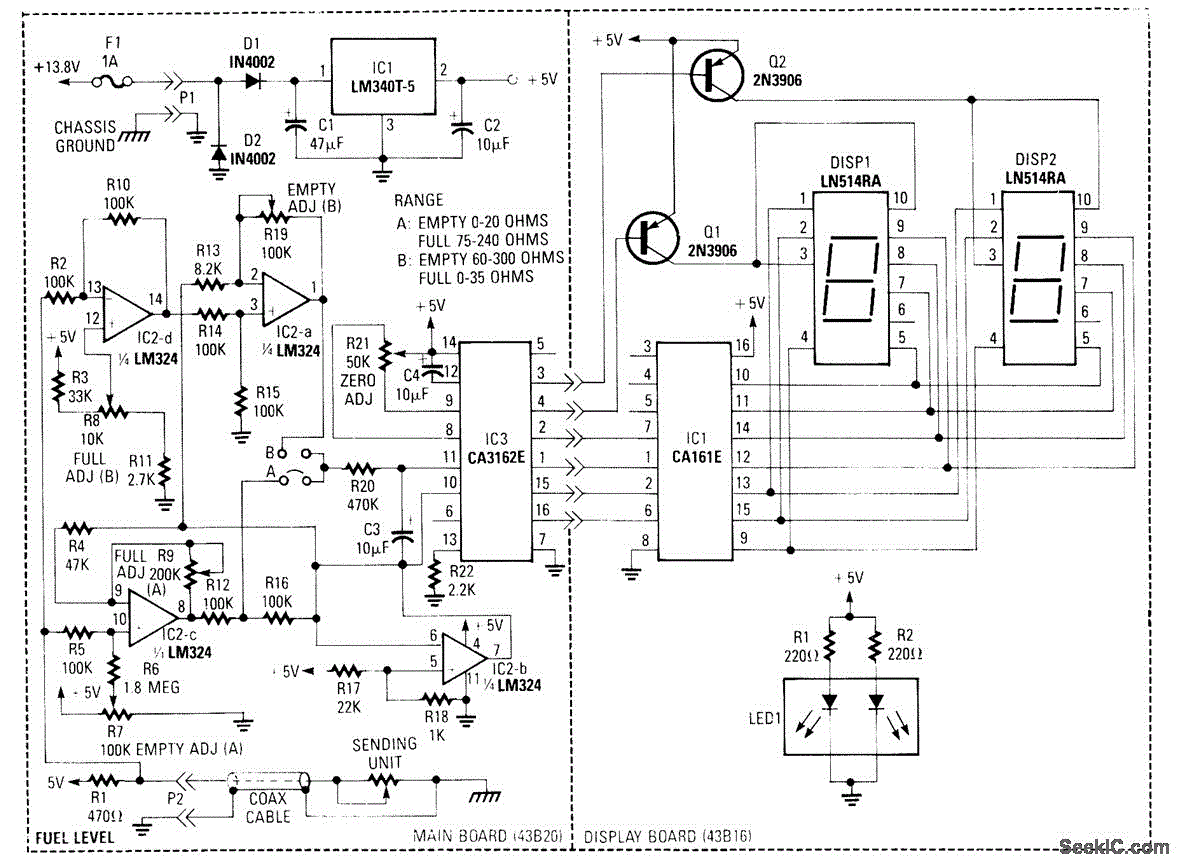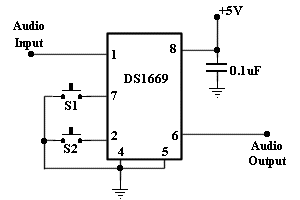
AT89C2051 Digital Thermometer and Clock

The MCU is an ATMEL 89C4051 CMOS Microcontroller featuring 4kB of code memory, 128 bytes of on-chip RAM, and 8-bit Port1 and Port3. The A/D chip is a HARRIS CA3162, which functions as a 3-digit digital voltmeter (DVM). This A/D converter utilizes a dual-slope integrator, enabling a sampling rate of 10Hz. The digital output sent to the MCU is a multiplexed four-bit BCD, starting from the most significant digit (MSD), least significant digit (LSD), and next significant digit (NSD) respectively. The MSD signal is connected to P3.7, indicating that the first digit is ready to be read. The integrating capacitor is a 330nF polyester type. A 10k potentiometer connected to pin 13 serves as a gain adjustment, while a 50k potentiometer connected to pins 8 and 9 is used for zero adjustment. The input to the converter is true differential, with pin 11 for the high signal and pin 10 for the low signal. Temperature measurements are taken using a precision solid-state sensor from National Semiconductor, the LM35D, which outputs a signal of 10mV/°C. Given that the A/D converter can provide readings from 0 to 1000mV with a resolution of 1mV, it can resolve changes of 0.1°C (not accounting for absolute accuracy). A 100k resistor and a 0.02µF capacitor form a first-order low-pass filter used for front-end hardware filtering. A 16x1 line LCD is interfaced in 4-bit mode to P1.4 through P1.7, with control signals RS and E connected to P3.4 and P3.5, respectively. The +5V power supply is regulated using a 78L05 in a TO92 package, powered by an external +9V adapter.
The ATMEL 89C4051 microcontroller serves as the central processing unit for the system, equipped with sufficient memory to handle the operations of the A/D converter and LCD display. The HARRIS CA3162 A/D converter is specifically designed for precision voltage measurements, employing a dual-slope integration technique to enhance accuracy and minimize noise. The output format of the converter, being a multiplexed four-bit BCD, allows for seamless communication with the microcontroller, which processes the digitized signals.
The temperature sensing component, the LM35D sensor, is chosen for its linear output, providing a straightforward conversion from temperature to voltage. The low-pass filter composed of a 100k resistor and a 0.02µF capacitor is critical for eliminating high-frequency noise from the temperature signal, ensuring that the readings are stable and accurate before being processed by the A/D converter.
The LCD interface is designed for efficient communication with the microcontroller, utilizing a 4-bit data mode to minimize the number of pins required for operation. The control signals for the LCD are managed through designated pins on the microcontroller, allowing for easy integration and control of the display.
Powering the entire system is accomplished through a 78L05 voltage regulator, which stabilizes the +5V output necessary for the microcontroller and associated components, ensuring reliable operation even when powered by an external +9V adapter. This design encapsulates a robust and efficient electronic measurement system suitable for various applications that require precise temperature readings and digital display output.The MCU is ATMEL 89C4051 CMOS Microcontroller having 4kB code memory, 128 bytes On-chip RAM and 8-bit Port1 and Port3. The A/D chip is HARRIS CA3162, 3-digit DVM. The A/D converter employs dual-slope integrator providing 10Hz sampling rate. Digital output sent to MCU is multiplex four bit BCD started from MSD, LSD and NSD respectively. The MSD signal was tied to P3. 7 indicating first digit ready to be read. Integrating capacitor is a 330nF Polyester type. The 10k POT connected to pin13 is a gain adjustment and 50k POT to pin 8 and 9 is for zero adjustment. The input of the converter is true differential pin 11 for HI and pin 10 LO signal. Temperature was measured by a precision solid-state sensor from National Semiconductor, LM35D. The output signal is 10mV/ °C. Since the A/D converter is capable of providing 0-1000mV reading with 1mV resolution, thus the converter can resolve 0.
1 °C (not absolute accuracy). A 100k and 0. 02uF forms a first order low-pass filter used to be front-end hardware filtering. The 16x1 line LCD is connected in 4-bit interfacing to P1. 4-P1. 7 with control signal RS and E to P3. 4 and P3. 5 respectively. The +5V power supply uses a 78L05 TO92 case with external +9V adapter. 🔗 External reference
The ATMEL 89C4051 microcontroller serves as the central processing unit for the system, equipped with sufficient memory to handle the operations of the A/D converter and LCD display. The HARRIS CA3162 A/D converter is specifically designed for precision voltage measurements, employing a dual-slope integration technique to enhance accuracy and minimize noise. The output format of the converter, being a multiplexed four-bit BCD, allows for seamless communication with the microcontroller, which processes the digitized signals.
The temperature sensing component, the LM35D sensor, is chosen for its linear output, providing a straightforward conversion from temperature to voltage. The low-pass filter composed of a 100k resistor and a 0.02µF capacitor is critical for eliminating high-frequency noise from the temperature signal, ensuring that the readings are stable and accurate before being processed by the A/D converter.
The LCD interface is designed for efficient communication with the microcontroller, utilizing a 4-bit data mode to minimize the number of pins required for operation. The control signals for the LCD are managed through designated pins on the microcontroller, allowing for easy integration and control of the display.
Powering the entire system is accomplished through a 78L05 voltage regulator, which stabilizes the +5V output necessary for the microcontroller and associated components, ensuring reliable operation even when powered by an external +9V adapter. This design encapsulates a robust and efficient electronic measurement system suitable for various applications that require precise temperature readings and digital display output.The MCU is ATMEL 89C4051 CMOS Microcontroller having 4kB code memory, 128 bytes On-chip RAM and 8-bit Port1 and Port3. The A/D chip is HARRIS CA3162, 3-digit DVM. The A/D converter employs dual-slope integrator providing 10Hz sampling rate. Digital output sent to MCU is multiplex four bit BCD started from MSD, LSD and NSD respectively. The MSD signal was tied to P3. 7 indicating first digit ready to be read. Integrating capacitor is a 330nF Polyester type. The 10k POT connected to pin13 is a gain adjustment and 50k POT to pin 8 and 9 is for zero adjustment. The input of the converter is true differential pin 11 for HI and pin 10 LO signal. Temperature was measured by a precision solid-state sensor from National Semiconductor, LM35D. The output signal is 10mV/ °C. Since the A/D converter is capable of providing 0-1000mV reading with 1mV resolution, thus the converter can resolve 0.
1 °C (not absolute accuracy). A 100k and 0. 02uF forms a first order low-pass filter used to be front-end hardware filtering. The 16x1 line LCD is connected in 4-bit interfacing to P1. 4-P1. 7 with control signal RS and E to P3. 4 and P3. 5 respectively. The +5V power supply uses a 78L05 TO92 case with external +9V adapter. 🔗 External reference





